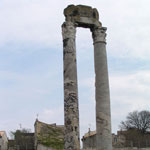
If you are looking for visible and comprehensible Roman remains, Arles is a good place to start. It was actually founded by Greeks from Massalia in the sixth century B.C. but came into its own starting in the first century B.C. when Julius Caesar conquered Massalia (49 B.C.) and incorporated its colonies into the growing Roman Empire. A prosperous trading city on the Rhône River, Arles became a colonia romana (the highest grade of Roman colony, the citizens of which were granted full Roman citizenship). It was renamed Colonia Julia Paterna Arelate Sextanorum (Arelate for short) by Augustus in honor of his great uncle and adoptive father, Julius. Arles/Arelate grew as a Roman town during the empire and was endowed with several impressive public buildings under Augustus and later emperors, including a forum, theater (begun late first century B.C.), amphitheater (late first century A.D.), temples, and an imperial palace and bath built under Constantine in the early fourth century. The famous Roman and Medieval cemetery, Les Alyscamps, is located along the Via Aurelia, the ancient road coming from Italy. The early Roman town was so magnificent that a mid-first-century writer described it as urbs opulentissime ("most opulent of cities")! The town shrank in importance, wealth, and size during the early Middle Ages but somewhat revived beginning in the 11th century. Today it is lively with tourists and many of its monuments have been added to the UNESCO World Heritage List.
The best-preserved Roman buildings today are the amphitheater and the theater.
 Amphitheater |
 Theater |
 Market |
|
Advertisement

Advertisement







